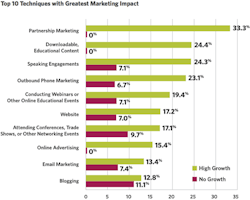If your firm is stuck in the doldrums of low growth and low profitability, you can do something about it. I’ve seen many firms make the transition from low to high performance. But it takes more than hot breath and high hopes to fill your sails with wind. It takes a strong commitment to change from everyone at the top of your organization — and an understanding that change may be difficult at first.
You’ll need to bring your leadership team together and resolve to modernize your marketing program. Discuss what implications this will have on your firm. For instance, it will mean spending marketing dollars in entirely new areas and, most likely, abandoning some techniques that you currently use. It will mean focusing more on creating and promoting content than publicizing your capabilities. It will mean shifting priorities from traditional referrals to educating your prospects and building trust.
The good news is that once you’ve made the transition from a traditional marketing mindset to a modern one, things get much easier. Everything starts to make sense, and the ship quickly picks up speed — leads, revenues and profits are growing again. It’s a thrilling experience!
Before that can happen, however, you will have to retool your approach to marketing. This will mean tapping new skills, investing in new technologies and upgrading old ones. Here are the top 10 marketing techniques as rated by high-growth firms and how they compare to their no-growth counterparts:
The first thing to note is that not one of these techniques is rated highly by no-growth firms. Clearly, they are relying on a largely different set of techniques than high-growth firms. While those results aren’t shown here, this includes traditional tactics such as sponsorships, print advertising and asking for referrals.
Below are seven key areas you will need to consider as you begin your journey to greater growth and profitability.
1. Prepare for online marketing: For most firms, the biggest adjustment is revving up and tuning an online marketing machine. Most firms don’t use online tools very effectively, and the vast majority aren’t equipped to tie these tools to financial results. Those things have to change. Aim for a roughly even mix of online and offline marketing techniques. Our research found that firms that invest in both grow up to 4X faster and are up to 60% more profitable than those that skew too far one way or the other.
2. Determine what’s working now: Some firms have greater success with traditional marketing techniques than others. If you’re able to secure new clients by exhibiting at tradeshows, then go ahead and include it in your mix. If you can’t tie a technique directly to new business, throw it out. Because most traditional techniques aren’t measurable, figuring out what works and what doesn’t can be a tough assignment.
3. Do your research: To truly understand how your firm fits into the marketplace, you need to do some foundational research. Upon these insights, you can build a powerful positioning for your firm. And if you can subsequently survey your clients on a regular basis, so much the better. In fact, high-growth firms are twice as likely to conduct ongoing research than no-growth firms.
4. Differentiate your business: If you aren’t specialized already, think about how you might narrow your firm’s focus. High-growth firms are 22% more likely to be specialized. Specializing and positioning your firm against others in your industry can be scary at first. But it is liberating, too. For the first time, you will be able to describe your firm in language that means something to your prospects — language that is memorable and sets you apart.
If specializing is impossible, you can take a different tack. Look for a feature or trait of your business that would resonate with your clients, then resolve to own it. Don’t worry if it isn’t unique in your industry so long as nobody else has beaten you to it.
5. Nurture strategic partnerships: The top technique in Hinge’s 2017 High Growth Study, partnership marketing is a natural for professional services. Start looking for firms, associations and other organizations that fit these criteria:
— Serves your target audience. Even if only a portion of a potential partner’s audience overlaps yours, they can still be a valuable asset.
— Doesn’t directly compete with you. In most cases, you don’t want to hook up with a competitor. Instead, look for complementary services. For instance, pure architecture, engineering and construction firms serve similar clients without directly competing (of course, firms, for example, that offer architecture and engineering services might not fit this model).
— Both sides can benefit from the relationship. Can you cross-market your services, pass referrals to each other or market to each other’s lists? You’ll want to structure your relationship so that the benefits are more or less equal, which can be a challenge if one organization is much larger or has broader exposure than the other.
6. Build a High-Performance Website: Your website is too valuable to be a passive piece of marketing collateral. It should be a lead-generating, trust-building content platform — and the centerpiece of your marketing program. It’s where you will house free educational content and your blog. It’s the mechanism that will attract new prospects, and it’s where you will convert them into leads. It’s also the place where you will promote your Visible Experts®, those professionals in your organization that want to raise their industry profile and increase the perceived value of your firm. To learn more about how to transform your website into your most important marketing asset, be sure to download our free Lead Generating Website Guide.
7. Measure everything and adjust: High-growth firms monitor 33% more metrics than no-growth firms. Most online marketing tools come with robust analytics, so think about which metrics will be most helpful to you. It’s easy to become overwhelmed by the available data, so you will want to build a dashboard that covers the essentials. Most firms monitor metrics on a weekly, monthly and quarterly basis. To the extent you can, keep an eye on the performance of your offline tactics, too. How many speaking engagements are your team conducting, and want kinds of people are they getting in front of? How many phone inquiries are you receiving, and where did the prospects learn about you? How many proposals are going out each week, and what is your closing percentage? This only scratches the surface, of course. Marketing is one giant laboratory, so don’t be afraid to experiment. If a particular tactics appears to be underperforming, try changing it, or abandon it altogether.
The mechanics of firm growth should not intimidate you. Building a marketing program that produces healthy, sustained growth may take some time, but it is a realistic, achievable goal for most low-performing firms.
Extracted from: https://hingemarketing.com/blog/story/firm-growth-a-primer-for-professional-services
About the Author
Hinge
Hinge is the leading branding and marketing firm for professional services. Our ongoing research into high-growth firms is changing the way firms go to market. Our services include everything a firm needs to become a market leader—from research and strategy to visual brands and marketing implementation. Follow us on Facebook, LinkedIn, Twitter, and YouTube.

